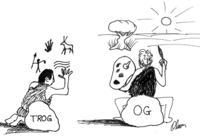Artists come a dime-a-dozen
Artists come a dime a dozen. I’m not saying that in a rude way, since I consider myself to be somewhat of an artist. I’m just saying it’s not as easy to be a financially successful artist. A few get lucky, but the fact is that there is more involved in the marketing of art than pure artistic skill. If you take any group of artists, some famous and some not, you will often see no difference in the quality of their work. Yet some can sell their paintings for thousands of dollars and others can only give their work away.
Maybe the stuffy art critics can see the qualitative difference between all art, but I’d say their standards are fifty percent arbitrary and forty percent standardized mental mind-cloning. Critics say that in order to appreciate art we have to see the meaning behind the art. Well, I’m sure they’re right ten percent of the time. But most artists don’t paint some mystical story into all of their paintings. In fact, I’d go so far to say that only a small percentage of art was created with a spiritual purpose. Most art, including the so-called classics, were probably created with the most common artistic spark: pure creative joy.
Maybe the art critics, like English teachers, were taught that you have to look for meaning in a piece because they lack any personal artistic traits. An artist, like a creative writer, almost always does his work for the sheer joy of doing it. A painter paints because he just wants to paint a good picture, just as a writer writes to tell a good story. Seldom is a painting created with the idea that the art has something beyond itself. The artist wants to impress people with images, but an image is only a collection of colors and shapes with potential meaning. Most meaning is supplied by the viewer.
Take the Mona Lisa. Why is it a classic? What, artistically speaking, makes it so enduring? Is there something metaphysically intrinsic about it? Is it any more a piece of art than any other portrait that any number of other artists could have done? Or is it a classic simply because of the name of the artist who created the piece?
Artistic greatness is something of a fad. Critics like to deride various artists as "illustrators”, as if there is something debased about their work. An illustrator is not, according to critics, a fine artist. But where do you draw the line between illustration and fine art? One artist recently made the point that it would be interesting to know how many classic artists spent their time illustrating books and cards. She made the statement that many so-called illustrations would be pieces of so-called fine art were they only painted on canvas instead of poster board.
Critics like to make all kinds of qualifiers to what makes fine art fine. You can’t use an airbrush or computer graphic program to be a fine artist. I guess this is because it is essential to know that a brush smeared across canvass to make a scene rather than a misty spray of paint.
Perhaps I’m just not cultured enough. I’m sure that’s what a critic would say. But you know, I really don’t care about what a critic would say. I know that some pieces of art make me feel curious or intrigued, others bore me. I can’t see why anyone needs a critic to say which paintings are beautiful and which ones have spirit. My advice is to never ask a critic to take you on a tour in an art museum.
- Essays on Art
These essays talk about art and the value of art.
- Artists come a dime-a-dozen
- The Value of Art
- Creative Arts
- Related Topics





